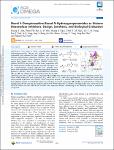Search
Author
- Do T. M. Dung (3)
- Duong T. Anh (3)
- Jong S. Kang (2)
- Joo-Hee Kwon (2)
- next >
Subject
- Acetohydrazides (1)
- caspase activation (1)
- Chemical libraries (1)
- Drug discovery and dev... (1)
- next >
Date issued
Has File(s)
Search Results
Two series of novel 4-oxoquinazoline-based N-hydroxypropenamides (9a–m and 10a–m) were designed, synthesized, and evaluated for their inhibitory and cytotoxicity activities against histone deacetylase (HDAC). The compounds showed good to potent HDAC inhib |
In our continuing search for novel small‐molecule anticancer agents, we designedand synthesized a series of novel (E)‐N'‐(3‐allyl‐2‐hydroxy)benzylidene‐2‐(4‐oxoquinazolin‐3(4H)‐yl)acetohydrazides (5), focusing on the modification of sub-stitution in the quinazolin‐4(3H)‐one moiety. The biological evaluation showed thatall 13 designed and synthesized compounds displayed significant cytotoxicity againstthree human cancer cell lines (SW620, colon cancer; PC‐3, prostate cancer; NCI‐H23, lung cancer). The most potent compound5ldisplayed cytotoxicity up to 213‐fold more potent than 5‐fluorouracil and 87‐fold more potent than PAC‐1, the firstprocaspase‐activating compound. Structure–activity relationship analysis revealedthat substitution of either electron‐withdrawing or electron‐releas... |
In our search for novel small molecules activating procaspase-3, we have designed and synthesized two series of novel (E)-N'-arylidene-2-(2-oxoindolin-1-yl)acetohydrazides (4) and (Z)-2-(5-substituted-2-oxoindolin-1-yl)-N'-(2-oxoindolin-3-ylidene)acetohydrazides (5). Cytotoxic evaluation revealed that the compounds showed notable cytotoxicity toward three human cancer cell lines: colon cancer SW620, prostate cancer PC-3, and lung cancer NCI-H23. Especially, six compounds, including 4f–h and 4n–p, exhibited cytotoxicity equal or superior to positive control PAC-1, the first procaspase-3 activating compound. The most potent compound 4o was three- to five-fold more cytotoxic than PAC-1 in three cancer cell lines tested. Analysis of compounds effects on cell cycle and apoptosis demonstr... |


